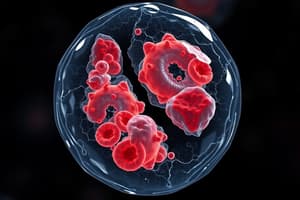Podcast
Questions and Answers
What is the purpose of cell division?
What is the purpose of cell division?
- To prevent genetic variation
- To produce identical cells (correct)
- To decrease surface area to volume ratio
- To decrease cell numbers
What is the difference between diploid and haploid cells?
What is the difference between diploid and haploid cells?
- Haploid cells have two pairs of every chromosome
- Diploid cells have half the number of chromosomes
- Haploid cells have three pairs of every chromosome
- Diploid cells have two pairs of every chromosome (correct)
What is the function of mitosis and cytokinesis?
What is the function of mitosis and cytokinesis?
- To increase cell numbers and surface area to volume ratio (correct)
- To produce genetically varied gametes
- To decrease cell numbers
- To prevent genetic variation
What are homologous chromosomes?
What are homologous chromosomes?
What is somatic cell division?
What is somatic cell division?
What is the purpose of meiosis?
What is the purpose of meiosis?
What is interphase?
What is interphase?
Flashcards are hidden until you start studying
Study Notes
- The cell cycle consists of stages that increase cell numbers and surface area to volume ratio.
- Cell division serves various purposes, including repairing/replacing cells and producing identical cells.
- Chromosomes are packets of DNA, and homologous chromosomes contain the same gene sequence.
- Diploid cells have two pairs of every chromosome, while haploid cells have half the number of chromosomes.
- Mitosis and cytokinesis serve essential functions in growth, maintenance, and repair of damaged tissue.
- Meiosis produces four genetically varied gametes that undergo fertilization to produce a zygote.
- Somatic cells are body cells that undergo cell division called Mitosis and Cytokinesis.
- Interphase is the preparation phase for somatic cell division.
- Meiosis I is the reduction division and recombination phase, while Meiosis II divides haploid daughter cells to form four gametes.
- Meiosis produces gametes with half the number of chromosomes to prevent doubling in every generation.
Studying That Suits You
Use AI to generate personalized quizzes and flashcards to suit your learning preferences.



